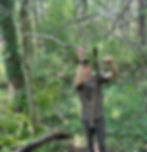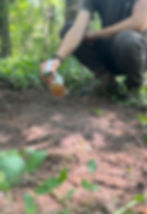How to Make a Mock Scrape That Attracts Mature Bucks
- Greg Kazmierski
- Sep 8, 2023
- 6 min read
Introduction
One of the more recent popular tactics in the whitetail deer hunting world is how to make a mock scrape, one that whitetail bucks will actually use. Not all scrapes are created equally, and scrape activity will vary from community scrapes to a scrape line exiting a mature buck bedding area.
Mastering the art of creating mock scrapes can provide many hunters with a strategic advantage. These carefully crafted simulations of natural deer behavior have proven to be effective tools for attracting more bucks and improving your odds in the woods.
Below we will dive into the ins and outs of making mock scrapes that yield tangible results. Whether you are planning on making your first actual mock scrape, or it has been something you have been doing for years, understanding the techniques behind successful mock scrapes can elevate your whitetail game to the next level.
Understanding Mock Scrapes
Mock scrapes, in essence, are imitations or 'fake scrapes' of an actual scrape site that deer create as a means of communication. These mock scrapes simulate the social interactions of all whitetails, big bucks, little bucks, does, and even yearlings.
Different scrapes serve different functions at different times of the year. The most common scrapes hunters try to imitate are the ones designed for the rutting season when bucks become more active in hub type areas, mark their territory, and communicate with does.
When you shift your focus to make a mock scrape in a high odds type of area, you strategically position your scrape location and stand location for a higher chance of encounters with a mature buck.

Selecting the Right Location

Choosing the optimal location for a mock scrape is a pivotal decision that can determine the success of your hunting scenario. Mock scrapes that are designed to hunt over should be strategically positioned in areas frequented by deer with high odds of catching a buck cruising in daylight, such as along established travel corridors on the down wind side of doe bedding areas.
Although a scrape line along field edges may be an enticing place to add in a mock scrape at your desired stand location, the high traffic areas rarely see any real buck movement during daylight hours.
Tools and Equipment

To craft an effective mock scrape, it's essential to gather the right tools and equipment. A post hole digger proves invaluable for creating a realistic scrape pit, while an overhanging branch serves as the symbolic licking branch.
These elements contribute to the authenticity of the mock scrape and increase its allure to passing deer. Additionally, ensuring the area around the mock scrape is cleared of debris and excess vegetation further enhances its appeal.
Creating the Mock Scrape
Crafting a successful mock scrape involves a meticulous process. The art of creating a convincing mock scrape lies in attention to detail and an understanding of deer psychology.
Finding the perfect tree, being conscious of human scent (ground scent and access), and many other factors go into the process, so let's take a look.
Step 1: Site Selection
Begin by identifying a suitable site that aligns with deer movement patterns. Look for areas with evidence of high activity, such as tracks, droppings, and a heavy deer trail. These signs indicate that whitetails frequent the location, making it an ideal spot for your mock scrape.
Focusing on pinch points will further enhance success as these are areas a buck makes a priority while navigating the landscape as they are the path of least resistance and allow them to cover the most ground.

Step 2: Clearing the Area

Clear the chosen area of leaf litter, excess vegetation, and other debris. You want the mock scrape to stand out in the woods, so ensure that you work up the ground so the bare dirt is visible and accessible. This cleanliness enhances the allure of the scrape to passing bucks.
Using a rake to excavate a shallow pit in the exposed soil can often be the easiest and quickest way to get the job done. Rakes come in all different shapes and sizes, and I have used everything from a handheld rake on public land to a heavy duty one on private farms.
The dimensions of the scrape should resemble those of real scrapes, typically around 3 to 5 feet in diameter. Enough that deer will have to commit to entering into the scrape in order to work their way through the travel corridor or your desired hunting area. This will ensure the most scent possible is released and becomes even more of a pull for other bucks.
Step 3: Installing the Licking Branch

Adjacent to the scrape pit, install a sturdy overhanging licking branch that comes down to around chest high from the surrounding one or two trees. This branch serves as the symbolic licking branch you often see in multiple scrapes in the woods, where deer will rub their preorbital and tarsal glands.
This behavior transfers scent onto the licking branch and the ground below, mimicking real deer interactions. This collection of scent works as a communication hub for the herd and lets other deer know who is in the area.
Step 4: Attractants and Scents

Consider using attractants and scents to further entice deer to visit the mock scrape. Applying a combination of dominant buck urine and doe urine can amplify the allure of the area, making it even more appealing to passing whitetail.
An alternative to synthetic urines that we have seen work time and time again is human urine. I'm sure we have all heard stories of someone urinating in the scrape on the way to the blind and shooting their target buck that same night. While we recommend being a little more delicate in the approach, whatever works!
Step 5: Regular Maintenance

Maintaining the mock scrape is essential for its effectiveness. Refresh the scrape each spring/summer by raking the soil and monitoring the area for activity to see if any adjustments are needed. This consistent maintenance increases the longevity of the scrape's appeal.
Using Deer Attractants
Whitetails are highly scent-driven creatures, and incorporating the right attractants can significantly amplify the effectiveness of your mock scrape. There are plenty of options available on the market, my best advice is to find a brand that has provided results in situations similar to yours, believe in the product, and utilize it on your property.
Deer scents and deer urine are powerful tools that can draw deer to your mock scrape. Applying these scents strategically to the scrape and the surrounding area can pique the curiosity of passing bucks and does. Utilizing a combination of dominant buck urine and doe estrus can create an illusion of social interaction, making your mock scrape even more enticing.
Trail Cameras and Monitoring
Technology has revolutionized the world of hunting, and trail cameras have become indispensable assets for every hunter's toolkit. Mock scrapes can be made specifically for trail camera purposes as a way to gather inventory in your area.
When developing a mock scrape specifically for the pictures you may not get many pictures during daytime hours or legal light, but the information provided can be your ticket to success the first week of rutting activity.
Reviewing the images and videos captured by these cameras provides valuable insights into deer movement patterns, visitation frequency, and the presence of a mature buck. This data-driven approach empowers hunters to make informed decisions and adjust their strategies accordingly.

Hunting Strategies

Incorporating mock scrapes into your hunting strategy involves more than just creating the scrape itself. Positioning yourself strategically in relation to the mock scrape, bedding areas, and food sources is crucial. Study the prevailing wind direction and use it to your advantage when choosing your hunting location.
Placing your stand downwind from the mock scrape ensures that your scent is carried away from the potential path of approaching deer. This strategic positioning increases your odds of a successful hunt.
Conclusion

Mastering the art of creating mock scrapes is a dynamic skill that can yield remarkable results in the world of whitetails. By understanding the behavior of deer, selecting the right locations, using the appropriate tools, and timing your efforts effectively, you can create mock scrapes that attract mature bucks and enhance your hunting success.
Implementing these techniques alongside advanced tools like a trail camera and sound hunting strategies can transform your hunting experience and bring you closer to your goal of a successful harvest.

